10.2 Unique Storage Organs
Learning objectives
By the end of this lesson you will be able to:
- Characterize the differences between bulbs and other storage organs.
- Describe techniques for propagating plants with different clonal strategies from storage organs.
- Demonstrate other ways in which plants colonize through natural clonal propagation.
Geophytes
Plants called geophytes have evolved to store carbohydrates and nutrients underground in special structures which allow them to regenerate during the growing season.
Unlike trees and shrubs that keep their dormant buds above ground during the winter, some plants keep their dormant nodes underground. Other plants may grow and store their nodes under water in a pond or stream. Many orchid species live in trees and are called epiphytes. The specialized storage organs have several roles which allow them to perenniate and colonize. This short video will introduce some of the special organs that you are likely already familiar with (3:27).
These organs store carbohydrates that can be used for rapid growth when favorable conditions return. They protect the nodes from injury from herbivory and injury (frost and freeze), and are a natural form of cloning by producing new daughter plants away from the mother plant. The plant propagator uses techniques that take advantage of these natural processes and can therefore rapidly increase the number of plants.
Bulbs
The onion and lily family (Liliaceae; monocots) are typical examples of bulb-producing herbaceous perennials. The bulbs are subterranean, which prevents them from predation and weather conditions. Bulbs consist of a highly condensed stem (with nodes and internodes) and adventitious roots that form along the basal plate. Two main types of bulbs include imbricate and tunicate. Imbricate bulbs, typical of some lily species, consist of scales, as shown in the photo below. Scales are specialized leaves that form radially around the meristem. During the growing season, leaves and a stem emerge from the soil from the center of the plant, where the apical meristem is located. These above-ground leaves are able to photosynthesize. The central meristem converts to a floral meristem where flowers are produced. New lateral bulblets form from the meristem in axils underground, allowing the plant to colonize and perenniate. In some cases, the main bulb may not continue to grow as the meristem has converted to flowering. The new bulbelts can be removed to produce new daughter plants. The plant propagator can remove scales from the bulb and create a new daughter plant from each. This scaling technique is highly effective, though it may take several years for the new plantlet to flower again.
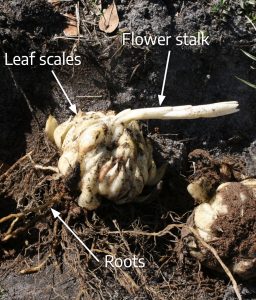
Tunicate bulbs (below), or those with paper coverings, are exemplified by onions, tulips, and garlic. Specialized leaves make up the mass of the storage organ for the plant and form concentric rings around the meristem. Typically, when we cut an onion from the tip through the root end, we can see the layers of leaves (the parts that we eat) and then stem at the bottom. We know it is a stem because there are nodes and internodes. When cooking, we typically discard the stem, basal plate, and adventitious roots. To view the different structures of a bulb during the growing season, look in particular at green onions, scallions, and leeks. Newer leaves form in the interior of the bulb (the apical meristem is in the middle) and the papery skin is the oldest layer formed. From the middle of the bulb, leaves emerge to photosynthesize when the conditions are right, and the floral meristem emerges from the middle. Lateral tunicate bulblets may form inside the main bulb, or along the exterior at the basal plate, especially if there is an injury. Scooping the basal plate is one way to induce bulblet formation. The basal plate can also be scored to have a similar effect.

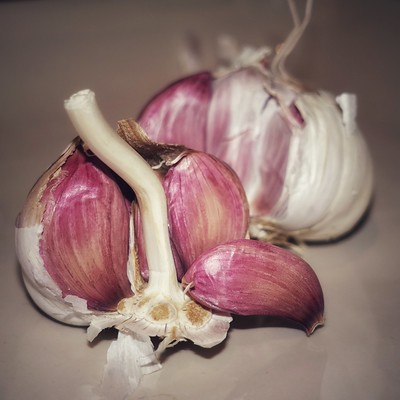
To propagate a tunicate bulb, it can be sectioned in many pieces by cutting from top to bottom through the basal plate. The sections are allowed to dry for a few days, treated with a fungicide, and then planted in a cold frame or other suitable system to induce bulb formation and plant regeneration. It may take several seasons for the bulbs to develop a suitable size for flowering. When doing any sectioning, scaling, scoring, or scooping the tools should be cleaned between cuts, or at the very least between bulbs, to prevent the spread of disease. Alcohol is suitable for killing microbes and for cleaning the cutting surface and fingers.
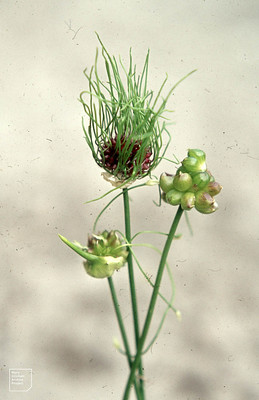
Liliaceae is unique in that bulb-like organs may also form above ground. In this family, bulbils, shown in the photo above, are formed in the leaf axils above ground or in some flowers. Bulbils are clonal (asexual) propagation and not formed through pollination. When the lily’s flower stalk dies, it falls to the ground and the bulbils are scattered away from the mother plant. This colonization strategy is highly effective and can be very weedy for the gardener. Mature or “ripe” bulbils can be removed from the plant and potted as soon as they easily detach. Alternatively they can “self sow” and be moved the following spring.
Some bulbs develop contractile roots that pull the bulbs into the soil. As bulbs grow each year, they would logically move closer to the surface, putting them at risk. The contractile roots are able to get the bulb to the proper depth after a growing season.
Corms
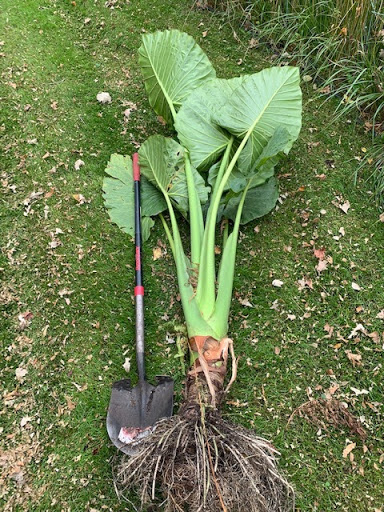
Like bulbs, corms are underground storage structures that have evolved in some plants. Corms are a storage unit made of compressed stems, unlike the leaves that provide the storage function in bulbs. Because they are stems, corms have nodes, internodes, and meristems just like above-ground stems. The roots of corms are adventitious and develop from a basal plate and nodes. Corms may be short-lived in herbaceous perennials like Gladiolus, where a new corm is replacing itself regularly; in tropical climates, taro (Alocasia) may grow for several years with the same corm structure. The giant elephant ear plant above shows a corm structure. Corms reproduce asexually through cormels, akin to the bulblets produced by bulbs. Watch this short video (0:47) to see a closeup of this corm.
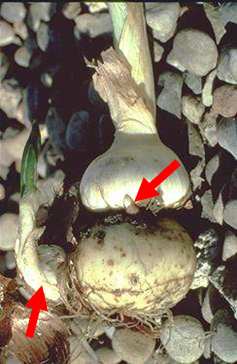
Corms can be induced to produce cormels by removing the apical bud, which removes dominance and stimulates new growth at the nodes. This is generally not necessary, as many corm-producing plants naturally increase with new corms annually. In the photo above, the corm on the left shows the aggressive nature of colonization. The oldest corm at the bottom is being replaced by the actively growing corm attached above it. We can also see two cormels that have formed (red arrows). Eventually the lower, older corm will dessicate and decompose. This is a great example of why some geophytes have contractile roots, for in one growing season the newest cormel could grow above the soil surface.
Rhizomes
Rhizomes are also underground stems. The Canna lily (below) produces large rhizomes each year. Notice how it looks a lot like ginger “root;” the two plants are in the same family. As stems, they have nodes that produce shoots and they have adventitious roots. Rhizomes typically grow horizontally at or near the soil surface. Some grasses use rhizomes to help with rapid colonization from the crown. Rhizomes can be divided into many pieces as a way to produce multiple clonal propagules.
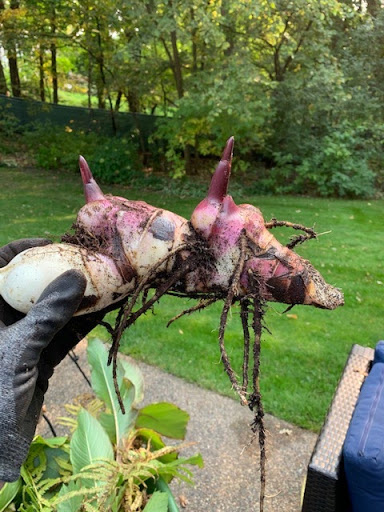
Tubers
Potato (Solanum tuberosum L.) is the typical example of a common plant that uses a tuber for storage and propagation. Tubers are another example of an underground stem, with nodes and internodes. The nodes may not be obvious when the potato is fresh from the grocery store, but in storage the potato may grow “eyes” which are new shoots that are growing from the once dormant nodes. Most people have seen this in their pantry or on the kitchen counter. To plant potatoes, the farmer cuts up pieces of the last year’s potatoes so there are enough carbohydrates and nodes for a new plant to emerge from the soil.
Roots
We’ve already learned that roots play an important role in storing nutrients for plants. Biennial plants like carrots, parsnip, and beets have fleshy roots which help them overwinter. These are not easy to propagate into new plants and typically are grown from seed. Horseradish and some poppy plants, however, can easily be propagated from root cuttings. A common example of a tuberous root is the sweet potato (looks like a tuber, functions like a root). The common garden radish (Raphanus sativus) may seem like a root, but close investigation reveals that it is mostly the swollen hypocotyl (image below).

Other methods of colonization
Crowns
Hosta plants are common examples of herbaceous perennials that are excellent at colonizing through an underground crown. The underground stem grows radially each year. New shoots can be removed, as shown below. Notice the adventitious roots. Many perennial grasses, asparagus, and other herbaceous perennial plants can be divided into multiple new plants, taking advantage of this colonization strategy. Offshoots (sometimes called pups) can be removed from the mother plant and replanted elsewhere.
Agave plants – which are used to produce tequila – are clonally reproduced this way, as seed production results in new genetic recombinations that are different from the mother plants. Clonal propagation ensures reproducibility for uniform forms and consistent tequila production. Gardeners have been using this method to propagate plants for millenia.
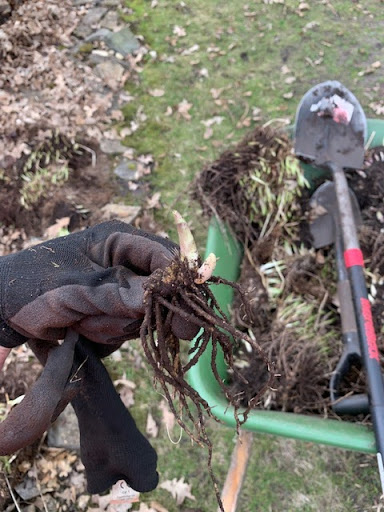
Stolons
Perennial grasses and strawberry (Fragaria spp., photo below) are excellent examples of plants that produce runners or stolons that extend the reach of the mother plant for colonization. These above-ground stems (there are underground examples as well) are not for storage, as in the previous examples, but are adaptations to reduce local competition with the mother plant while also spreading her genetic material. A strawberry stolon may root adventitiously at a node and produce a new plant from the bud (remember, buds are located at nodes and form into new shoots). The stolon likely will continue to grow and do the same at each node thereafter. A gardener can peg the stolon into the soil to help the plant root, then remove it later and replant it.
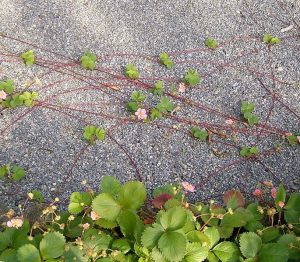
Stem layering
Plants with stems that creep along the soil or whose shoot tips bend and touch the soil take advantage of being able to form adventitious roots for colonization. Some raspberry species (Rubus occidentalis), for example, grow long canes after fruiting, which extend beyond the mother plant and push their shoot tips into the soil. In the photo below, the plant grows roots and reorganizes the developing shoot (see how the leaves face upward). Now anchored into place, a new crown can form, often several feet from the mother plant. Vining and climbing plants often can root at each node, which makes them able to grow along the forest floor until they find a structure to climb. This adaptation can allow clones of the same plant to “move” over time to conditions that are more favorable. This may be more evident in tropical regions, where plants grow faster and local conditions can change suddenly. Vining plants, like grape (Vitis), are often easy to root from hardwood cuttings because they have evolved to root quickly at a node.
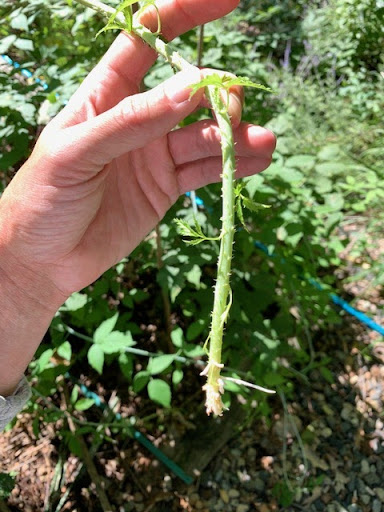
New growth begins underground and the function of the underground growth is storage of food, nutrients, and water during adverse environmental conditions.
Underground storage organ formed primarily of modified leaves (scales) without a papery covering. Individual scales do not encircle the entire bulb.
An underground storage organ formed primarily of modified leaves formed in concentric circles around the active meristem. The bulb is covered with a papery covering.
A condensed stem, storage organ, typically grown underground and covered in scale leaves.
Horizontal stem growing just below the soil surface.
Stem with long internodes that grows along the surface of the ground.

